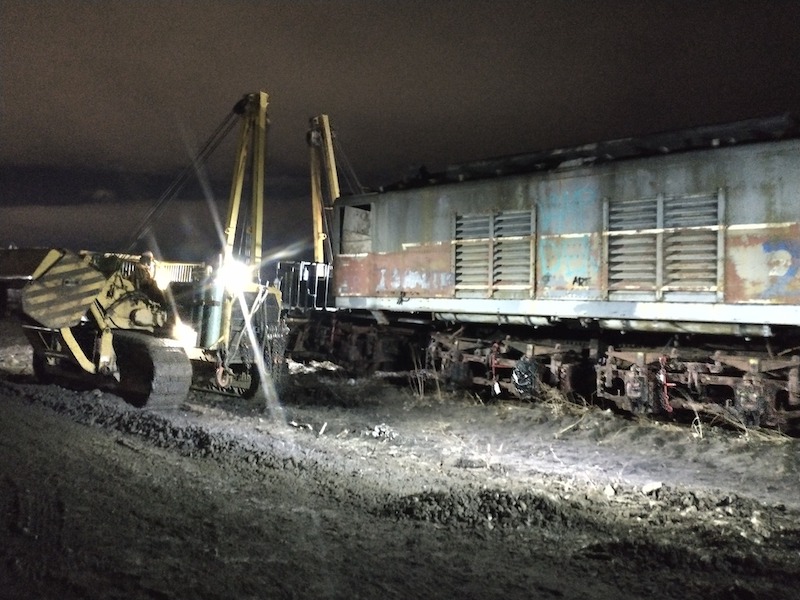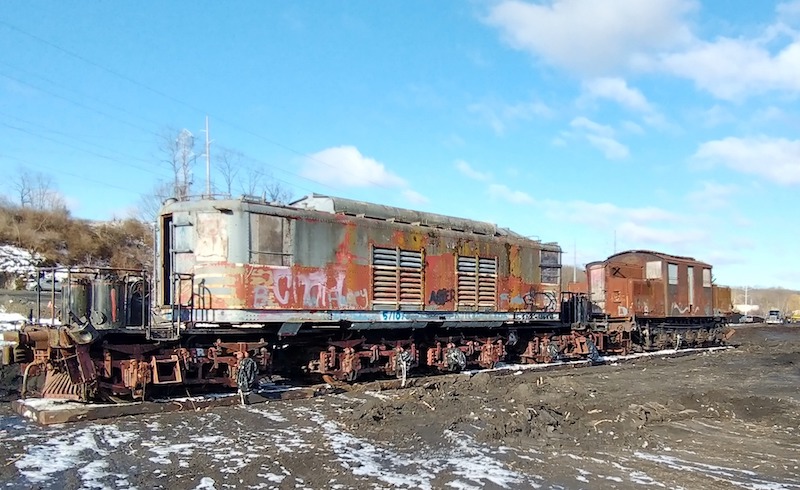By Justin Franz
GLENMONT, N.Y. — Two rare New York Central electrics have been temporarily moved out of the way of a new development at an old power plant near Albany, N.Y., giving their owner more time to raise funds and move them to a permanent home.
On December 19, railroad contractor Hulcher Service, Inc., successfully relocated NYC S-1 6000 and T-3a 278 about 200 feet east of their previous location to a spot where they can safely stay until being moved to their new home, the Danbury Railway Museum in Connecticut. The museum, which has owned them since 2013, has been working on preparing the two motors to move for much of the year, but earlier this month it looked as if that effort would fail. Costs of the move had skyrocketed dramatically and the developer of a new wind turbine tower factory wanted them moved immediately.
“This is really a pivotal moment, and the point of no return,” said DRM president Jose Alves. “For years we have worked to save these locomotives and our plans have finally begun to pay off. This could not have been accomplished without our volunteers, in particular, a core group of dedicated, hardworking volunteers; Paul Marsh (who has been involved long before the DRM took ownership), Dave Pickett, and Project Manager Stan Madyda”
The locomotives both received “slight damage” during the move, which took place with the help of four “side boom” cranes. Museum officials said the two motors will be disassembled for final movement to Danbury. No timeline has been set for that move and additional funding is required. Museum officials also thanked Henry Posner, III, chairman of the Railroad Development Corporation, for financial support of the project.

New York Central T-Motor 278 is moved at Glenmont, N.Y., on December 19.
“Now that the locomotives have been moved to a staging area, we will separate them into individual components and prepare them for shipment,” Madyda said. “This is a huge moment, but we are not out of the woods yet. The movement to a staging area was required by The Port to facilitate the construction of an access road which will later play a part in the removal of the locomotives.”
The S-1 was the only of its kind ever built and was the prototype that all of the NYC’s future electric locomotives were built on, including the T-3a. T-3a 278 is the sole survivor of 36 such locomotives built between 1913 and 1926. The T-3a electrics were among the Central’s most powerful and hauled everything from commuter trains to the 20th Century Limited. Once larger and more powerful locomotives were acquired, the S-motors found a new role as switchers working in the subterranean depths of Grand Central Terminal, with some surviving in active service until 1981. Only a handful of electric locomotives survived into the Penn Central era, replaced by dual-mode FL9s absorbed from the New Haven fleet. T-motor 278 found a new home assigned to the wire train in Sunnyside Yard in Queens (since the T-motor could draw power from the third rail in the tunnels while the overhead wire was repaired).
The odd non-revenue assignments proved to be the only way these historic electric locomotives were saved. The S-motor and T-motor were acquired by the Mohawk & Hudson Chapter of the National Railway Historical Society in the 1980s and given a cosmetic restoration and placed on display at the local fairgrounds. In 1988, they were hauled back to Grand Central Terminal to be used in a scene in the 1988 film “The House on Carroll Street,” starring Kelly McGillis and Jeff Daniels. After that, they were returned to M&H Chapter and moved to their present location in Glenmont. In the decades since, the Chapter was no longer able to care for the increasingly isolated units located on private property. While they have been heavily vandalized over the years, they remain good candidates for cosmetic restoration.
The effort to save the two electrics has become a decade-long saga, one beset with challenges for the non-profit Danbury group. Among those challenges is the location of the motors, which are cut off from the rail network and surrounded by infrastructure that hinders their movement. The electrics were joined by a number of other pieces of equipment, including a rare U25B, but it and others were sacrificed to try and save the even rarer electrics.
Those interested in making a donation can visit DanburyRail.org/electrics.



